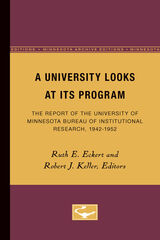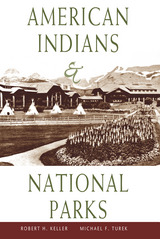2 books by Keller, Robert

Ruth Eckert
University of Minnesota Press
A University Looks at its Program was first published in 1954.Educational research, which first demonstrated its value in the fields of primary and secondary teaching, has been extended in comparatively recent times to the college and university level. The University of Minnesota has been a pioneer in the development of research methods to investigate problems of higher education. Its program of self-study was inaugurated in the early 1920’s under the far-seeing administration of the late Lotus D. Coffman.The 23 studies presented here are illustrative of the educational research conducted under the Minnesota plan during the decade of 1942 to 1952. They are a representative selection from a much larger number of studies sponsored during that period by the University’s Committee on Educational Research (now designated as the Committee on Institutional Research). The problems investigated are of four major types: those of a general character, such as enrollment trends or curriculum developments; those related to the undergraduate programs; those associated with specialized and graduate programs; and those connected with staff activities. The Minnesota self-study plan has been flexible and broad; no question has been considered too small to probe if its answer seemed likely to help some staff member or student group, and no proposal has been ruled out as over-ambitious if the information sought would help to build a sound program.These reports will be useful to college and university administrators, faculties, and research specialists for the clear picture they give of the scope and methods of a research program designed to help an educational institution in its long-term planning.
[more]

American Indians and National Parks
Robert H. Keller and Michael F. Turek
University of Arizona Press, 1998
Many national parks and monuments tell unique stories of the struggle between the rights of native peoples and the wants of the dominant society. These stories involve our greatest parks—Yosemite, Yellowstone, Mesa Verde, Glacier, the Grand Canyon, Olympic, Everglades—as well as less celebrated parks elsewhere. In American Indians and National Parks, authors Robert Keller and Michael Turek relate these untold tales of conflict and collaboration. American Indians and National Parks details specific relationships between native peoples and national parks, including land claims, hunting rights, craft sales, cultural interpretation, sacred sites, disposition of cultural artifacts, entrance fees, dams, tourism promotion, water rights, and assistance to tribal parks. Beginning with a historical account of Yosemite and Yellowstone, American Indians and National Parks reveals how the creation of the two oldest parks affected native peoples and set a pattern for the century to follow. Keller and Turek examine the evolution of federal policies toward land preservation and explore provocative issues surrounding park/Indian relations. When has the National Park Service changed its policies and attitudes toward Indian tribes, and why? How have environmental organizations reacted when native demands, such as those of the Havasupai over land claims in the Grand Canyon, seem to threaten a national park? How has the Park Service dealt with native claims to hunting and fishing rights in Glacier, Olympic, and the Everglades? While investigating such questions, the authors traveled extensively in national parks and conducted over 200 interviews with Native Americans, environmentalists, park rangers, and politicians. They meticulously researched materials in archives and libraries, assembling a rich collection of case studies ranging from the 19th century to the present. In American Indians and National Parks, Keller and Turek tackle a significant and complicated subject for the first time, presenting a balanced and detailed account of the Native-American/national-park drama. This book will prove to be an invaluable resource for policymakers, conservationists, historians, park visitors, and others who are concerned about preserving both cultural and natural resources.
[more]
READERS
Browse our collection.
PUBLISHERS
See BiblioVault's publisher services.
STUDENT SERVICES
Files for college accessibility offices.
UChicago Accessibility Resources
home | accessibility | search | about | contact us
BiblioVault ® 2001 - 2024
The University of Chicago Press









